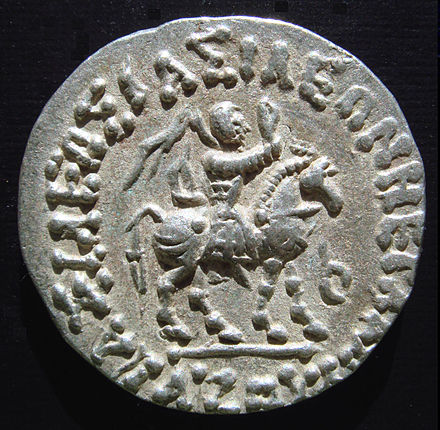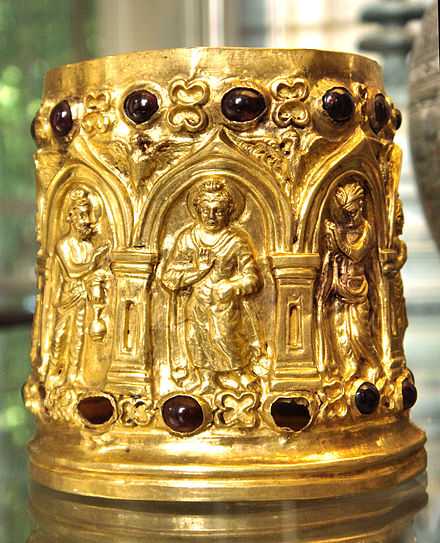Este artículo necesita citas adicionales para su verificación . ( enero de 2010 ) ( Aprenda cómo y cuándo eliminar este mensaje de plantilla ) |
| Azes II | |
|---|---|
| Rey indoescita | |
 Azes II con armadura, montado a caballo, en uno de sus tetradracmas de plata , acuñado en Gandhara. | |
| Reinado | Escitas : quizás del 35 al 12 a. C. |
| Predecesor | Azilises |
| Sucesor | Zeionises / Kharahostes |
Azes II ( griego : Ἄζης , epigráficamente ΑΖΟΥ Azou ; Kharosthi : 𐨀𐨩 Aya , Aya ; [1] tanto de Saka * aza- ., Que significa "líder" [2] ), puede haber sido la última indo-escita rey, se especuló que reinó alrededor del año 35-12 a. C., en el subcontinente indio del norte (actual Pakistán). Su existencia ha sido cuestionada; si él no existiera, artefactos atribuidos a su reinado, como monedas, es probable que sean los de Azes I . [3]
Después de la muerte de Azes II, el gobierno de los indo-escitas en el noroeste de la India y Pakistán finalmente se derrumbó con la conquista de los kushans , una de las cinco tribus de los yuezhi que habían vivido en Bactria durante más de un siglo y que estaban luego se expandió a la India para crear un Imperio Kushan. Poco después, los partos invadieron desde el oeste. Su líder Gondophares desplazó temporalmente a los Kushans y fundó el Reino Indo-Parthian que duraría hasta mediados del siglo I EC. Los kushan finalmente recuperaron el noroeste de la India alrededor del año 75 d.C., donde prosperaron durante varios siglos.
Dedicatorias budistas [ editar ]

Ataúd de bimaran [ editar ]
Azes II is also connected to the Bimaran casket, one of the earliest representations of the Buddha. The casket was part of the deposit of Stupa 2 in Bimaran, near Jalalabad in Afghanistan, and placed inside the stupa with several coins of Azes II. This event may have happened during the reign of Azes (35–12 BCE), or slightly later. The Indo-Scythians are otherwise connected with Buddhism (see Mathura lion capital and the multiple Buddhist dedications of the Apracas), and it is indeed possible they would have commended the work. However it now thought that a later king, issuing coins in the name of Azes, such as Kharahostes, made the dedication.
Butkhara stupa[edit]
A coin of Azes II was found under a pillar with an Indo-Corinthian capital and sculpture of a Buddhist devotee in the Butkara Stupa, suggesting the involvement of Azes II in Buddhist dedications, and a datation for the sculpture corresponding to the reign of Azes II.[4]
Coinage[edit]
Las monedas atribuidas a Azes II usan inscripciones griegas y Kharoshti, representan a una diosa griega como su protectora y, por lo tanto, siguen esencialmente el modelo numismático de los reyes griegos del reino indo-griego, lo que sugiere una gran disposición a adaptarse a la cultura griega. Una diferencia novedosa de los indoescitas era mostrar al rey a caballo, en lugar de su busto de perfil, como hacían los griegos.
Otras monedas de Azes representan el león budista y la vaca brahmánica de Shiva , lo que sugiere tolerancia religiosa hacia sus súbditos. En la moneda representada a la izquierda, Azes está representado con las inscripciones:
- Obv: King with coat of mail, on horse, holding a sceptre, with Greek royal headband. Greek legend ΒΑΣΙΛΕΩΣ ΒΑΣΙΛΕΩΝ ΜΕΓΑΛΟΥ ΑΖΟΥ "The Great King of Kings Azes".
- Rev: Athena with shield and lance, making a hand gesture identical to the Buddhist vitarka mudra. Kharoshti legend MAHARAJASA RAJADIRAJASA MAHATASA AYASA "The Great King of Kings Azes", with the Buddhist triratna symbol in the left field.
Durante mucho tiempo se creyó que Azes II había emitido varias de las monedas indoescitas acuñadas con el nombre de Azes en el norte de la India . Sin embargo, todas estas monedas probablemente fueron emitidas por un solo gobernante llamado Azes , como sugirió Robert Senior, cuando encontró un golpe de una moneda atribuida a Azes I sobre una moneda atribuida a Azes II, lo que sugiere que todas las monedas "Azes II" eran no más tarde que los de "Azes I" y que solo había un rey en la dinastía llamado Azes. [5] Esta idea había sido defendida durante mucho tiempo por Senior con una serie de argumentos numismáticos indirectos, por ejemplo, en su enciclopedia de monedas indoescitas. [6]
Galería de monedas [ editar ]
Retrato de Azes II
Coin of Azes II with Buddhist triratna symbol.
Coin of Azes II.
Coin of Azes II, with a clear depiction of his military outfit, with coat of mail and reflex bow in the saddle.
Coin of Azes II, with king seated, holding a drawn sword and a whip.
Seated king Azes II
Profile of king Azes II.
Coin
See also[edit]
- Ahir
- Ancient India and Central Asia
- Greco-Bactrian Kingdom
- Indo-Greek Kingdom
- Indo-Parthian Kingdom
- Kushan Empire
- Tillia tepe
- Yuezhi
Footnotes[edit]
- ^ Edmund Zygman, A Tetradrachm of Azes II struck at Sāngala-Euthydemia, Museum Notes (American Numismatic Society). Vol. 7 (1957), pp. 51-56.
- ^ Harmatta, Janos 1999, Languages and scripts in Graeco-Bactria and the Saka kingdoms in Harmatta, J, BNPuri and GF Etemadi (eds), History of civilizations of Central Asia,volume II, The development of sedentary and nomadic civilizations: 700 BC to AD 250, Motilal Banarsidas, Delhi, p. 399.
- ^ Senior (2008), pp. 25-27.
- ^ Handbuch der Orientalistik, Kurt A. Behrendt, BRILL, 2004, p.49 sig
- ^ Senior, R. The final nail in the coffin of Azes II, and Azes: an unpublished an important tetradrachm S861T, Journal of the Oriental Numismatic Society 197, 2008
- ^ Senior, R. Indo-Scythian Coins and History, (4 volumes), CNGcoins, London, England and Lancaster, Pennsylvania
References[edit]
- Senior, R. C. (2008). "The Final Nail in the Coffin of Azes II." Journal of the Oriental Numismatic Society 197 (2008), pp. 25–27.
- The Shape of Ancient Thought. Comparative studies in Greek and Indian Philosophies by Thomas McEvilley (Allworth Press and the School of Visual Arts, 2002) ISBN 1-58115-203-5
- The Greeks in Bactria and India, W. W. Tarn, Cambridge University Press.
External links[edit]
- Coins of Azes II
- Coins of Azes II on wildwinds.com
| Preceded by Azilises | Indo-Scythian Ruler (35–12 BCE) | Succeeded by In Kashmir: Zeionises In Mathura: Kharahostes |
| vteIndo-Scythian kings, territories and chronology (in green) | |||||||||||||||||||||||||||||||||||||||||||||||||||||||||||||||||||||||||||||||||||||||||||||||||||||||||||||||||||||||||||||||||||||||||||||||||||||||||||||||||||||||||||||||||||||||||||||||||||||||||||||||||||||||||||||||||||||
|---|---|---|---|---|---|---|---|---|---|---|---|---|---|---|---|---|---|---|---|---|---|---|---|---|---|---|---|---|---|---|---|---|---|---|---|---|---|---|---|---|---|---|---|---|---|---|---|---|---|---|---|---|---|---|---|---|---|---|---|---|---|---|---|---|---|---|---|---|---|---|---|---|---|---|---|---|---|---|---|---|---|---|---|---|---|---|---|---|---|---|---|---|---|---|---|---|---|---|---|---|---|---|---|---|---|---|---|---|---|---|---|---|---|---|---|---|---|---|---|---|---|---|---|---|---|---|---|---|---|---|---|---|---|---|---|---|---|---|---|---|---|---|---|---|---|---|---|---|---|---|---|---|---|---|---|---|---|---|---|---|---|---|---|---|---|---|---|---|---|---|---|---|---|---|---|---|---|---|---|---|---|---|---|---|---|---|---|---|---|---|---|---|---|---|---|---|---|---|---|---|---|---|---|---|---|---|---|---|---|---|---|---|---|---|---|---|---|---|---|---|---|---|---|---|---|---|---|---|---|
| |||||||||||||||||||||||||||||||||||||||||||||||||||||||||||||||||||||||||||||||||||||||||||||||||||||||||||||||||||||||||||||||||||||||||||||||||||||||||||||||||||||||||||||||||||||||||||||||||||||||||||||||||||||||||||||||||||||
| |||||||||||||||||||||||||||||||||||||||||||||||||||||||||||||||||||||||||||||||||||||||||||||||||||||||||||||||||||||||||||||||||||||||||||||||||||||||||||||||||||||||||||||||||||||||||||||||||||||||||||||||||||||||||||||||||||||